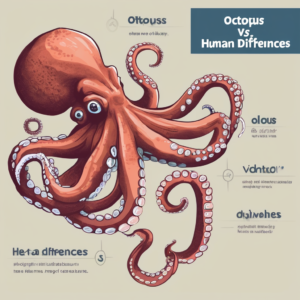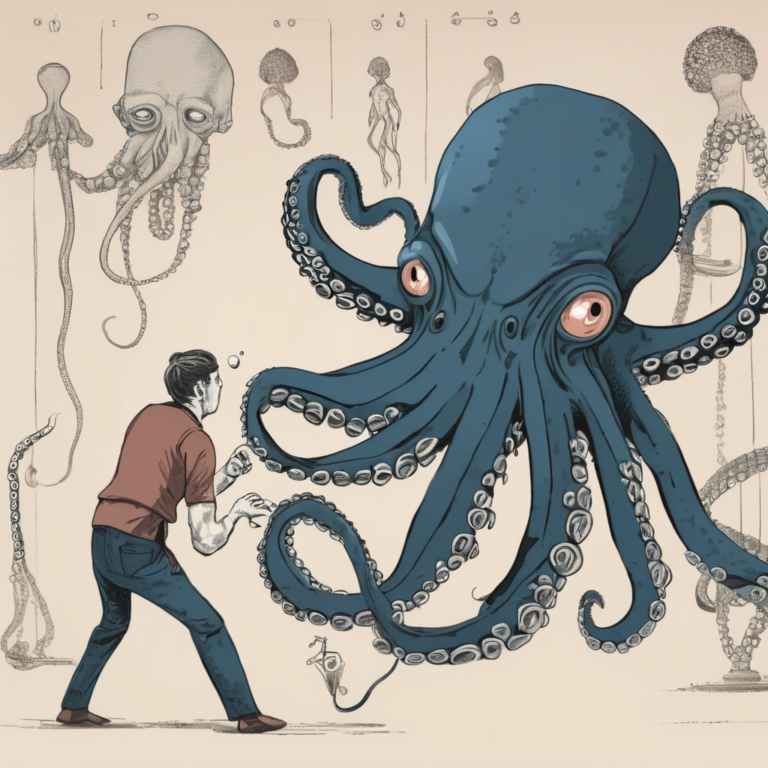Octopus Compared to Human
Octopuses are fascinating creatures known for their unique characteristics, such as their ability to change color and shape. When compared to humans, octopuses vary greatly in size, with the largest species reaching up to 16 feet (4.9 meters) in length. Their intelligence and problem-solving abilities also set them apart from humans, making them truly remarkable creatures to study.
Discover the Surprising Similarities and Differences Between Octopus and Human
Uncover fascinating facts about the weight and height comparison between octopus and human, and be amazed by the unique characteristics of these two creatures. Dive into this article to gain a deeper understanding of the incredible world of marine life and human anatomy.
Octopus Size
Octopuses come in a range of sizes, with the average size varying among different species. When comparing octopus size to human size, it’s important to note that octopuses can range from a few centimeters to several meters in length, while humans typically range from 1.5 to 1.8 meters tall. This vast difference in size showcases the diversity of the octopus species compared to humans.
– Octopuses: range from a few centimeters to several meters
– Humans: typically range from 1.5 to 1.8 meters tall
Variability Among Species
Octopus size can vary significantly depending on the species. Some species, like the tiny Octopus wolfi, are as small as a centimeter, while the giant Pacific octopus can reach lengths of over 6 meters. This wide range of sizes among octopus species highlights their adaptability and evolutionary diversity compared to humans.
– Octopus wolfi: as small as a centimeter
– Giant Pacific octopus: lengths of over 6 meters
Octopus Weight
Octopuses vary in weight depending on their species, with the average weight range typically falling between 3 and 10 kilograms (6.6 – 22 pounds). In comparison, this is significantly lighter than the average human weight, which ranges from 62 to 80 kilograms (137 – 176 pounds). This difference in weight plays a crucial role in how octopuses behave and interact with their environment.
Weight Distribution and Behavior
- Octopuses have a unique body structure with most of their weight concentrated in their head and mantle, allowing them to move swiftly and efficiently underwater.
- This weight distribution enables octopuses to navigate complex underwater environments, hunt for prey, and evade predators with agility and precision.
- In comparison, humans have a more evenly distributed weight across their body, which affects their movement and abilities in different ways than octopuses.
Understanding the weight differences between octopuses and humans provides valuable insights into how these creatures have evolved to thrive in their underwater habitats. By examining the impact of weight distribution on behavior, researchers can further appreciate the unique adaptations of octopuses compared to humans.
Octopus Body Structure
Octopuses have a fascinating body structure that sets them apart from humans. When comparing the body structure of octopuses to humans, several key differences become apparent:
- Number of limbs: Octopuses have eight tentacles, while humans have four limbs (two arms and two legs).
- Skeletal system: Octopuses lack a rigid internal or external skeleton, unlike humans who have a bony skeleton for support and protection.
- Musculature: Octopuses have a complex system of muscles that allow them to move with agility and flexibility, unlike humans whose muscles are attached to a bony structure.
- Skin: Octopuses have the ability to change the color and texture of their skin for camouflage and communication, a feature not present in humans.
The unique body structure of octopuses enables them to move gracefully through the water and hunt for prey effectively. Their lack of a rigid skeleton allows them to squeeze through tight spaces and manipulate objects with their tentacles. In comparison, humans rely on their bony skeleton for support and mobility.
Overall, the body structure of octopuses showcases their remarkable adaptability and evolutionary success in their underwater environment, highlighting the differences between these fascinating creatures and humans.
 Octopus Intelligence
Octopus Intelligence
Octopuses are known for their remarkable intelligence and problem-solving abilities, often compared to human intelligence. Here are some key points to consider:
– Overview of Octopus Intelligence: Octopuses have a highly developed nervous system and complex behaviors that showcase their intelligence.
– Comparison to Human Intelligence: While octopus intelligence may not be directly comparable to human intelligence, they exhibit cognitive abilities that are impressive for their species.
– Examples of Intelligent Behavior: Octopuses have been observed using tools, solving puzzles, and even escaping from enclosures, demonstrating their cognitive prowess.
When comparing octopus intelligence to human intelligence, it is important to consider the different evolutionary paths that have shaped these distinct forms of intelligence. Octopuses have adapted to their marine environment in ways that are unique from humans, leading to fascinating differences in cognitive abilities and problem-solving skills.
Octopus Habitat
Octopuses are fascinating creatures that inhabit a variety of environments around the world. Understanding their habitats can provide insights into their behavior and adaptations compared to human living environments.
Description of Octopus Habitats
– Octopuses are commonly found in oceans, ranging from shallow coastal waters to deep-sea trenches.
– They prefer rocky crevices, coral reefs, and sandy bottoms where they can hide and hunt for prey.
– Some species of octopuses are known to inhabit Arctic and Antarctic waters, showcasing their ability to adapt to extreme conditions.
Comparison to Human Living Environments
– Octopuses live in aquatic environments, while humans predominantly inhabit terrestrial habitats.
– Octopuses do not build permanent homes like humans but instead rely on natural structures for shelter.
– The underwater world of octopuses is vastly different from the human-built environments on land, highlighting the diverse ways in which organisms interact with their surroundings.
Adaptations to Surroundings
– Octopuses have evolved various adaptations to thrive in their habitats, such as camouflage abilities to blend in with their surroundings.
– Their flexible bodies and ability to squeeze through tight spaces allow them to navigate complex underwater terrain.
– Octopuses demonstrate remarkable resilience in adapting to changing environmental conditions, showcasing their ability to survive and thrive in diverse ecosystems.
By exploring the habitats of octopuses and comparing them to human living environments, we gain a deeper appreciation for the unique adaptations and behaviors of these intelligent creatures. Further research and conservation efforts are essential to protect the delicate balance of marine ecosystems where octopuses play a vital role.
Octopus vs Human Interaction
When considering interactions between octopuses and humans, it is fascinating to observe the similarities and differences in behavior and responses. Here, we delve into the intriguing dynamics of octopus compared to human interactions:
Exploration of Interactions
– Octopuses are known to exhibit curiosity and intelligence when encountering humans, often displaying inquisitive behavior towards divers and researchers.
– Humans, on the other hand, may react with a mix of awe and caution when encountering octopuses in their natural habitat.
Comparison of Behavior
– Octopuses have been observed to exhibit complex problem-solving skills and even playful interactions with objects, showcasing their high level of intelligence.
– Humans, while also intelligent beings, may not always understand or predict the behavior of octopuses, leading to varied reactions and responses in different situations.
Conservation Efforts and Ethical Considerations
– Conservation efforts are crucial in ensuring the protection of octopus populations and their habitats, as human activities can impact these creatures.
– Ethical considerations arise when studying and interacting with octopuses, prompting researchers and enthusiasts to approach these interactions with respect and mindfulness towards these fascinating creatures.
By exploring the interactions between octopuses and humans, we gain a deeper understanding of the complexities and nuances in the relationship between these two distinct species. It is essential to approach these interactions with a sense of wonder and appreciation for the unique qualities that both octopuses and humans bring to the natural world.
Heading VIII: Conclusion
In conclusion, the octopus is a fascinating creature with unique characteristics that set it apart from humans. Throughout this article, we have explored various aspects of the octopus compared to humans, shedding light on their differences and similarities.
Recap of Key Points:
- Octopuses come in a range of sizes, with some species being much smaller than humans.
- When it comes to weight, octopuses are generally lighter than humans, but their weight distribution plays a crucial role in their behavior.
- The body structure of octopuses is vastly different from humans, enabling them to move and hunt with remarkable agility.
- Octopuses exhibit high levels of intelligence and problem-solving abilities, comparable to some aspects of human intelligence.
- Octopuses adapt to a variety of habitats, showcasing their ability to thrive in diverse environments.
- Interactions between octopuses and humans raise important considerations for conservation efforts and ethical treatment of these creatures.
Final Thoughts:
While octopuses and humans may differ in many ways, it is clear that these creatures are worthy of further exploration and study. By understanding the complexities of the octopus compared to human nature, we can gain a deeper appreciation for the diversity of life on our planet.


Comments are closed.